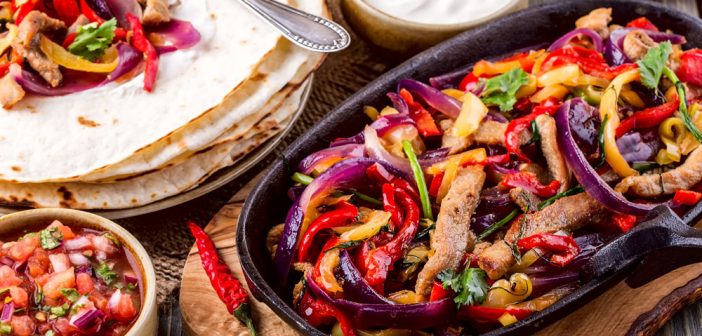Anyone can make fajitas. Making good fajitas, however, takes time and practice. Fajitas are a great dish to make for several reasons. They are a crowd-pleaser and they allow even picky guests to customize a dish to their own liking. Additionally, they have a characteristic smell and auditory sizzle that is especially enticing. Customizability is a massive part of what makes fajitas awesome, so creating your own version of them at home is a great way to develop a signature method and recipe.
The place to start with fajitas is the meat. Note that this doesn’t have to be meat, it can be tofu or another vegan alternative if this is what your diet calls for. In most recipes, the meat is soaked in a marinade for up to 24 hours before cooking. This gives the meat way more flavor when cooked and produces that signature fajita taste. These marinades usually contain an oil or other fat, an acid, as well as a blend of spices. For instance, olive oil, apple cider vinegar and a spice blend. Spice blends are usually made from chili powder, salt, pepper, adobo, cumin and many more. No exact recipe is needed here because the exact ratio of spices and the liquids chosen depends on the individual. Feel free to use a combination of spices that is to your liking.
There are several suitable types of meat that can be used in fajitas. One of the most common is beef. Traditionally, a skirt steak is used to make beef fajitas. Hanger steak, flap meat and beef round are also good choices. Ideally, any cut that is long and thin enough to cut into strips and isn’t too lean can be a solid choice. Chicken can be used for a lighter and healthier fajita. Chicken breasts are among the healthiest and easiest to prepare but using chicken thighs will have a deeper flavor profile. Finally, fajitas can be made with just vegetables or with vegan meat replacements. Tempeh, tofu and seitan all work well when prepared and flavored vibrantly.
Vegetables are an important element of the fajita. Usually, peppers and onions are used. Fajitas, however, are a flexible dish and can be used to clear out any leftover vegetable you might have. Regardless of the vegetable used, cut them into long strips or reasonable pieces and cook slowly in oil to soften. Add spices during this phase but note that this doesn’t have to be the same spice blend as was used in the meat. Contrast between meat and vegetable flavors is part of what makes this a great dish. Additionally, throwing in some garlic or herbs at this point can go a long way. Finally, at the end of cooking the vegetables, turn up the heat to get the classic, smoky charring that gives fajita vegetables their unique look and flavor.
A quality tortilla is needed to bring everything together. Store bought tortillas can be good, if you know which brands you like and don’t like. A better option, depending on your region, would be to buy freshly made tortillas from a Mexican grocery store. Obviously, this isn’t an option everywhere but if it is for you, take advantage of it. Finally, for a challenging but delicious meal, try making your own tortillas. It isn’t overly difficult to make them yourself, but it can be tough to get the hang of at first. There are several resources and videos online that can help you learn the process.
Regardless of the flavors and ingredients that you choose to use in your fajitas, try to pick high-quality ingredients where budget and availability allows. No matter how well a cheap cut of meat is cooked and seasoned, it is still a cheap cut of meat. Thus, certain elements, like taste and texture, of that meat will remain. Conversely, a nice cut of meat still tastes at least alright, even if cooked poorly. The same concept goes for vegetables and tortillas. Your dish will only be as good as the weakest element, so make sure all the elements are great.
After preparing the main dish components, you still need a spread. Most people will want a condiment or two to complete their fajitas. Most commonly, these include sour cream or Mexican crema. A common spread also includes salsa or other raw vegetables. Depending on your dish, however, you may wish to add other ingredients. Shredded cheese, mayo, hot sauce and tons of other ingredients can give your family or friends fun new flavors to add to their fajitas and create a delicious final product.
In this similar vein of experimentation, there are other less traditional ways to serve fajitas. For instance, a fajita quesadilla or fajita burrito. Both ideas take the components of a fajita and rearrange it. More creatively, you could make fajita mac and cheese or a fajita salad. The components that make up the classic fajita are incredibly flexible and the possibilities for meals are endless. Thus, consider experimenting. Not only with the meats and marinades used but also with how you put together and serve this timeless Tex-Mex classic dish.









